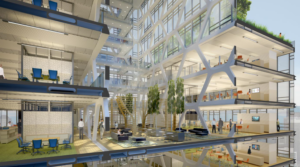COVID-19 Offers The Opportunity To Redesign The Physical Office

Image credit: Pickard Chilton
The pandemic crisis demonstrated that organizations must be prepared to have their knowledge workers work remotely at very short notice. In the wake of COVID-19, organizations are now forced to redesign their digital and physical workspaces for resilience and adaptability.
Moving forward, the traditional office setup will give way to a more hybrid work environment. In this arrangement, some people will work from home while others will work from the office — in a rotating manner. As a result, remote workers will no longer be second-class members of the workforce. So your physical office space will remain an important part of the overall work environment. Hence, as you prepare for people moving back to your offices, you need to:
- Pursue a spoke-and-wheel approach for a hybrid workforce. The future workforce will reflect more of a distributed workforce. There will still be main offices in city centers. However, employers will increasingly offer staff the option to relocate out of the city to suburban and exurban areas. This distance allows employees to commute a few days a week into the central office. There will also be greater use of regional offices as sub-offices. This arrangement will make it easier to attract and retain that pool of talent who prefer to work from outside major urban areas.
- Provide in-office experiences that stimulate collaboration among employees. The times of densification of office space to save money are over. This trend is reversing in light of COVID-19. While the overall office space in central urban areas might decline in coming years, the office space per employee in the office is likely to increase. Top employers will provide employees a modern office workspace to empower employees to engage with other employees outside a cubicle environment. This approach requires more space — potentially stemming the trend of office space reduction in central urban areas. As a result, the divergence between class A office space, with the best infrastructure, health and wellness facilities, and top locations, and class B office space will be widening. Top talent will be attracted to those businesses with class A office spaces.
- Reflect emerging health and safety regulations that will transform the physical office. To meet new health and safety regulations, offices will introduce measures such as contact tracing; temperature measurements; safe zones in elevators; markers on the floor to indicate personal space for workers; clock- or counterclockwise human traffic flows in the office to avoid employees passing each other; UV lights to disinfect office space; special air filters; and plexiglass barriers between office workers. A challenge will be to combine the desire for increased collaboration with the need for stricter health and safety regulations.
To be clear, a hybrid workspace strategy is essential to remain responsive to constantly changing conditions and rising expectations of connected customers. A resilient and adaptive organization must prepare for an exponential increase in activity from always-connected customers. A mobility strategy is critical to meet expectations of your remote workforce to seamlessly connect to systems of engagement and systems of record.
Our report An Adaptive Mobility Strategy helps tech and business leaders prepare their future workspace solutions. It will also help vendors of future workspace solutions position their offerings effectively.
